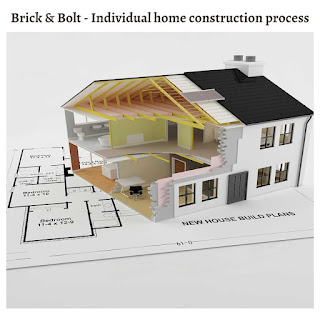BricknBolt: Why Transparency Is Key in Construction Projects

In any construction project, whether it’s a residence, a commercial building, or an industrial complex, transparency plays a crucial role in ensuring its success. Brick & Bolt, a trusted name in the construction industry, understands that transparency involves open communication, honesty, and providing stakeholders with all relevant information about the project. It helps create trust, fosters collaboration, and ensures that the project stays on track. In this blog, we’ll explore why transparency is essential in construction projects and how it leads to better outcomes for everyone involved.
Why Transparency Is Key in Construction Projects
1. Builds Trust Among Stakeholders
One of the most significant benefits of transparency in construction is that it builds trust among all parties involved in the project. Construction projects often have multiple stakeholders, including contractors, architects, suppliers, and clients. Each of these parties needs to rely on the others for the project’s success. When information is shared openly and accurately, it creates a sense of trust and ensures that everyone is working toward the same goal.
For instance, if the project manager openly communicates delays or issues with a supplier, they can work together to find a solution, rather than hiding the problem and allowing it to worsen. This collaborative approach helps build a healthy working relationship and increases the likelihood of project success.
2. Prevents Cost Overruns
In construction, costs can spiral out of control if proper oversight and transparency are lacking. Without transparency, it’s easy for hidden costs or miscommunications to arise, leading to unexpected expenses. However, when there is open communication about budget estimates, expenses, and potential changes, both the client and the contractors can stay on the same page regarding financial expectations.
Transparency allows for better tracking of materials, labour costs, and the allocation of funds, which reduces the risk of cost overruns. It also makes it easier to identify and address issues early on, avoiding expensive fixes later in the process. Using tools like real-time budget tracking and cost breakdowns can provide visibility into the financial health of the project at any given moment.
3. Ensures Timely Project Completion
Timely completion of a construction project is a top priority for clients and contractors alike. Transparency can help keep the project on schedule by ensuring that all parties are aware of deadlines, progress, and any obstacles that may arise along the way. If a delay occurs due to a supply chain issue, weather conditions, or workforce shortages, openly sharing this information with the team helps manage expectations and find ways to mitigate the delay.
4. Promotes Accountability
Transparency holds everyone accountable for their roles and responsibilities in the project. When everyone knows their duties and deadlines, they are more likely to take ownership of their work and deliver high-quality results. If something goes wrong, transparency ensures that the responsible party is identified, and corrective action can be taken quickly.
For instance, if a subcontractor fails to complete a task on time, transparency allows the project manager to address the issue immediately and find a solution. It also gives the client a clear understanding of where the project stands and who is responsible for each aspect. Accountability improves efficiency, minimises errors, and helps maintain the overall quality of the project.
5. Improves Communication and Collaboration
Effective communication is essential for any project’s success, and transparency is the key to ensuring open and honest communication between all parties involved. Whether it’s communicating changes in the design, budget adjustments, or delivery schedules, transparency ensures that everyone is aware of the latest developments and can contribute their expertise to solving problems.
By fostering a culture of transparency, teams can collaborate more effectively. For example, if the design team faces challenges with the architectural plan, they can communicate these challenges to the contractor early on, leading to a collaborative problem-solving approach. This early intervention helps prevent misunderstandings and costly mistakes later in the process.
6. Reduces Risk of Legal Issues
Construction projects are often subject to various legal requirements, including building codes, zoning laws, and contractual obligations. Transparency helps ensure that all legal aspects of the project are properly managed, reducing the risk of compliance violations or disputes. When contracts are clearly communicated, and all stakeholders understand their rights and obligations, the likelihood of legal problems decreases significantly.
If a client or contractor is uncertain about any aspect of the project’s legal standing, transparent communication helps clarify these issues. If disputes do arise, having a clear, documented trail of decisions, agreements, and changes can help resolve the issue quickly and fairly.
7. Enhances Client Satisfaction
Client satisfaction is often the most important measure of success for a construction project. Transparent communication ensures that clients are kept informed throughout the entire process, from the planning stages to the final handover. When clients are aware of any potential challenges or changes, they can make informed decisions and feel more in control of the project.
Regular updates on progress, along with clear explanations of any delays or budget changes, allow clients to manage their expectations. This level of transparency helps clients feel valued and respected, leading to higher satisfaction with the completed project.
8. Encourages Ethical Practices
Transparency in construction projects encourages ethical behavior among all stakeholders. When everyone knows that their actions are being observed and shared openly, it reduces the temptation to cut corners or engage in dishonest practices. Ethical behavior ensures that the project is completed with integrity, maintaining the highest standards of quality and safety.
Conclusion
Transparency is more than just a good practice in construction; it’s essential for the success of any project. Whether it’s building trust, preventing cost overruns, ensuring timely completion, or promoting accountability, transparency leads to better outcomes for all stakeholders. By fostering open communication, ethical behaviour, and enhanced collaboration, transparency helps construction projects run smoothly, on time, and within budget.
Brick & Bolt is a company that understands the importance of transparency in every construction project we undertake. Our commitment to open communication, clear timelines, and detailed cost breakdowns ensures that our clients stay informed and confident throughout the process. If you’re looking for a reliable construction partner who guarantees absolute transparency, visit the Brick & Bolt website today to get started on your next project.


Comments
Post a Comment